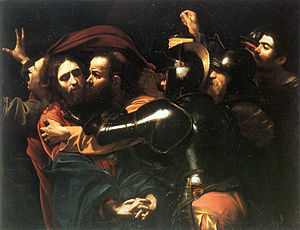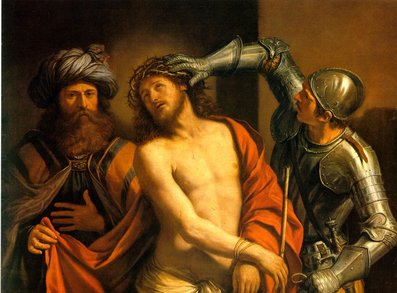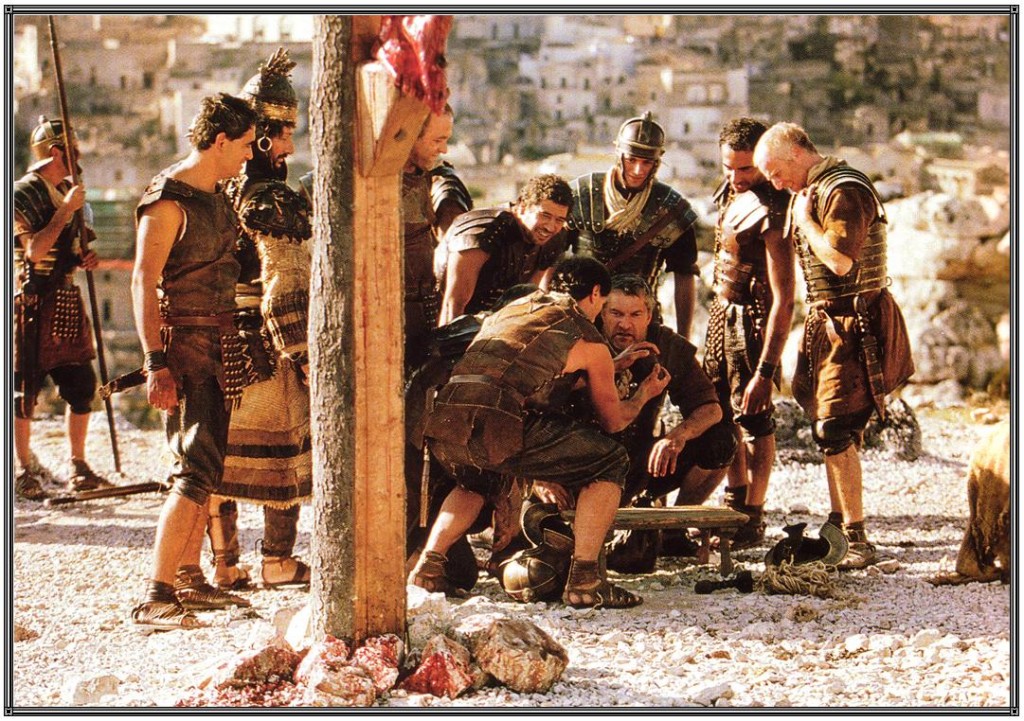Monthly Archives: March 2014
Jesus and the Centurion
A beautiful scene from “Jesus of Nazareth,” a television miniseries from 1977.
St. Patrick, March 17
Johnny I Hardly Knew Ye
An anti-war protest song against the British colonial wars in Ceylon ( Shri Lanka ) at the end of the 18th century. Sung by British opera singer Benjamin Luxon accompanied by American folk singer Bill Crofut on the banjo. e song is a monologue by an Irish woman who meets her former lover on the road to Athy, which is in County Kildare, Ireland. After their illegitimate child was born, the lover ran away and became a soldier. He was badly disfigured, losing his legs, his arms, his eyes and, in some versions, his nose, in fighting on the island of “Sulloon”, or Ceylon (now known as Sri Lank), and will have to be put in (or, in some versions, with) a bowl to beg. In spite of all this, the woman says, she is happy to see him and will keep him on as her beau.
While goin’ the road to sweet Athy, hurroo, hurroo
While goin’ the road to sweet Athy, hurroo, hurroo
While goin’ the road to sweet Athy
A stick in me hand and a tear in me eye
A doleful damsel I heard cry,
Johnny I hardly knew ye.
Chorus:
With your drums and guns and guns and drums, hurroo, hurroo
With your drums and guns and guns and drums, hurroo, hurroo
With your drums and guns and guns and drums
The enemy nearly slew ye
Oh my darling dear, Ye look so queer
Johnny I hardly knew ye.
Where are the eyes that looked so mild, hurroo, hurroo
Where are the eyes that looked so mild, hurroo, hurroo
Where are the eyes that looked so mild
When my poor heart you first beguiled
Why did ye scadaddle from me and the child
Oh Johnny, I hardly knew ye.
(Chorus)
Where are your legs that used to run, hurroo, hurroo
Where are your legs that used to run, hurroo, hurroo
Where are your legs that used to run
When you went to carry a gun
Indeed your dancing days are done
Oh Johnny, I hardly knew ye.
(Chorus)
I’m happy for to see ye home, hurroo, hurroo
I’m happy for to see ye home, hurroo, hurroo
I’m happy for to see ye home
All from the island of Ceylon
So low in the flesh, so high in the bone
Oh Johnny I hardly knew ye.
(Chorus)
Ye haven’t an arm, ye haven’t a leg, hurroo, hurroo
Ye haven’t an arm, ye haven’t a leg, hurroo, hurroo
Ye haven’t an arm, ye haven’t a leg
Ye’re an armless, boneless, chickenless egg
Ye’ll have to be put with a bowl out to beg
Oh Johnny I hardly knew ye.
(Chorus)
They’re rolling out the guns again, hurroo, hurroo
They’re rolling out the guns again, hurroo, hurroo
They’re rolling out the guns again
But they never will take my sons again
No they’ll never take my sons again
Johnny I’m swearing to ye.
Here’s a Joan Baez version:
Means, Motive, Opportunity
“You belong to your father, the devil, and you want to carry out your father’s desires. He was a murderer from the beginning, not holding to the truth, for there is no truth in him. When he lies, he speaks his native language, for he is a liar and the father of lies.” John 8:44
 An important new book called “Another 19: Investigating 9/11 Suspects” has been written by Kevin Robert Ryan, investigating “another 19” possible suspects besides Osama bin Laden and the handful of young Arabs, suspects who had three key things in any investigation: means, motive, and opportunity.
An important new book called “Another 19: Investigating 9/11 Suspects” has been written by Kevin Robert Ryan, investigating “another 19” possible suspects besides Osama bin Laden and the handful of young Arabs, suspects who had three key things in any investigation: means, motive, and opportunity.
Before you dismiss it as a “conspiracy theory,” keep in mind that the official narrative of 9/11 is itself a conspiracy theory which has not been proven true by any acceptable standard. For a quick overview of the official conspiracy theory, watch this well done video (five minutes):
Mike Lofgren on The Deep State
As a former Congressional staff member with top secret security clearance, Mike Lofgren crunched the numbers for 28 years as part of the House and Senate Budget Committees and found that the numbers didn’t add up. The numbers led him to connect the dots to America’s “deep state”: where elected and unelected figures collude to protect and serve powerful vested interests. He left the Republican party and wrote The Party Is Over.
Now he has written an essay called The Anatomy of the Deep State. It is a must-read.
An interview with Bill Moyers is below. “He says: I’m not a conspiracy theorist…This is something that hides in plain sight. It’s something we know about but we can’t connect the dots, or most people can’t.”
He talks about a hybrid of corporate America and the national security state. He also talks about Group Think, “a kind of assimilation of the views of your superiors and peers,” a all out plague in Washington.
Moyers: “If the ideology of the deep state is not right or left, Democrat or Republican, what is it?”
Lofgren: “It’s an ideology. I just don’t think we’ve named it. It’s kind of corporatism. Now the actors in this drama tend to steer clear of social issues. They pretend to be merely neutral servants of the State giving the best advice possible on national security or financial matters, but they hold a very deep ideology of the Washington consensus at home, which is deregulation, outsourcing, de-industrialization and financialization and they believe in American exceptionalism abroad, which is: boots on the ground everywhere, it’s our right to meddle everywhere in the world, and the result of that is perpetual war.”
He does end on a hopeful note:
Jesus, Remember Me
War and Families: The Uncounted
Suicides are increasing among parents, spouses, children, and siblings of veterans.
“I was pretty afraid of my dad when he came back from Iraq. I didn’t know who this man…You can’t forget being terrified of your parent and terrified for your life.”
“I am married to a Marine who has been through five deployments…I think that I had just been lonely for so long that it felt like maybe I didn’t matter.”
“I lost my daughter two years later. She took her life over the death of her brother. She couldn’t handle the pain of her brother’s death.”
“I hadn’t even begun to comprehend Freddie’s death. He was killed in action. How could my brother take his life? I had lost my whole family, and all I could think about would it would be better if I was gone too.”
Soldiers are not heroes
in the Gospel of Saint John, the story of the passion of the Christ.
John 18: “So Judas got a band of soldiers and guards from the chief priests and the Pharisees and went there with lanterns, torches, and weapons….”
…So the band of soldiers, the tribune, and the Jewish guards seized Jesus, bound him, and brought him to Annas first.
…And the soldiers wove a crown out of thorns and placed it on his head, and clothed him in a purple cloak, and they came to him and said, Hail, King of the Jews! And they struck him repeatedly.”
 “Now since it was preparation day, in order that the bodies might not remain on the cross on the sabbath, for the sabbath day of that week was a solemn one, the Jews asked Pilate that their legs be broken and that they be taken down. So the soldiers came and broke the legs of the first
“Now since it was preparation day, in order that the bodies might not remain on the cross on the sabbath, for the sabbath day of that week was a solemn one, the Jews asked Pilate that their legs be broken and that they be taken down. So the soldiers came and broke the legs of the first
and then of the other one who was crucified with Jesus. But when they came to Jesus and saw that he was already dead, they did not break his legs, but one soldier thrust his lance into his side, and immediately blood and water flowed out.”
John 19: “When the soldiers had crucified Jesus, they took his clothes and divided them into four shares, a share for each soldier. They also took his tunic, but the tunic was seamless, woven in one piece from the top down. So they said to one another, “Let’s not tear it, but cast lots for it to see whose it will be, “ in order that the passage of Scripture might be fulfilled that says: They divided my garments among them, and for my vesture they cast lots…”
“This is what the soldiers did.”
Give Me Love
(Give me peace on Earth)




